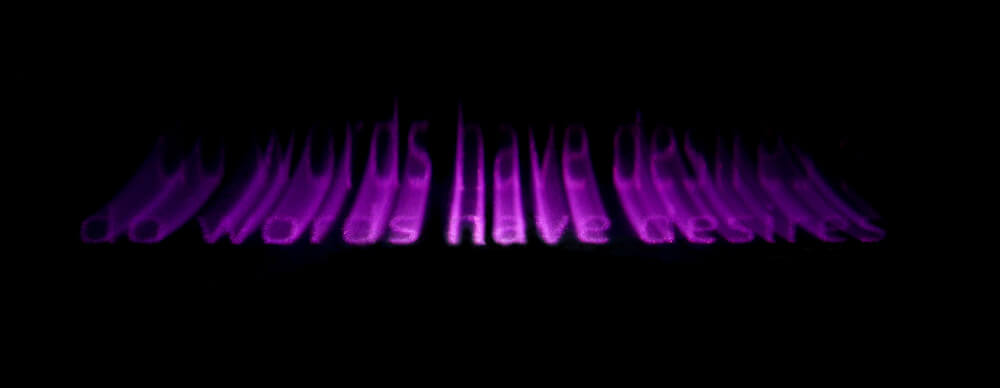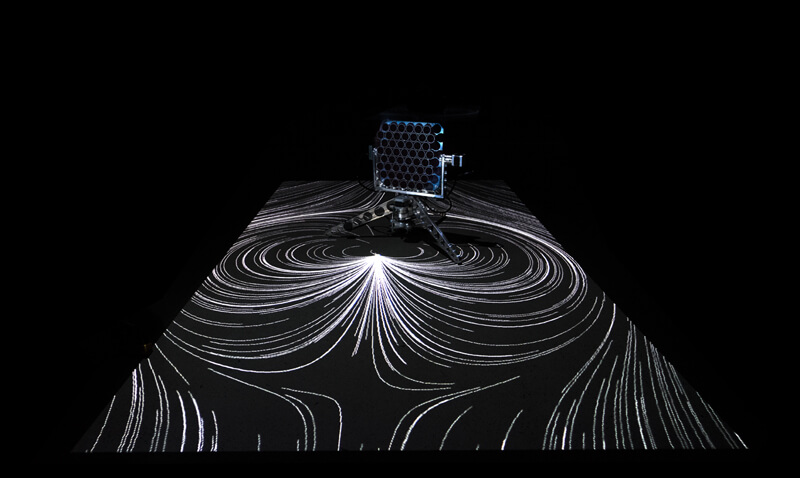Text by Lika Posamari

Sometimes words are noise. Sometimes, people are noise. Sometimes, feelings are noise. Narrow your focus, concentrate. Feel the noise. Filter the noise. Turn the noise over. We often consider language as what is spoken. Gail Priest’s work questions the flipside; the language of listening. As I am carried into the audiovisual world of SonoLexic, I begin to imagine.
I learn that imagination is based on sonic memories. The sounds that the work shares progressively become seen, and the visuals become heard to me. I begin to hear and see the constant flow of rain, which appears as solid grey lines to the eye. At other times the visual vibrations appear like fine hairs catching the breeze atop skin under a microscope.
The colours blur into flat lines, like how colours merge when you peer out the window of a moving vehicle, passing the scene by. Listening = perception + imagination. I am then guided to wonder, at what point does language cease to be shaped and form words? What are the underlying sounds of words when words are partially formed? SonoLexic explores a new type of synaesthesia, ideasthesia, loosely defined by Dank Nicolić as ‘sensing sound’.
A stereo and ultrasonic hyper-directional speaker brings a voiceover in conversation with a glowing plasma tube that offers visuals, sometimes in the form of words, sometimes shapes. Do words have desires of their own floats across the screen? This is a meeting of seeing, hearing, perceiving and imagining.
From stereo, multidirectional sound to a sound beam of precision. Adam Donovan and Katrin Hochschuhoffer a visual manifestation of what we hear, or as Gail Priest encourages us to question, sounds we may see and visuals we may hear. This brings the rare opportunity to sit with a precise point of sound as it moves through space.
The Curious Tautophone robot is controlling the inputs here. I am mesmerized by the fine silver lines that form curves in constant motion, evolving in their formations. Some dancing toward the centre, others away from it. Gliding and sliding as the sound also circulates, as I move in and out of conscious awareness. Both eyes and ears are invited to follow.
Is my latent memory darting before me as I see spiders’ legs or feel my fingers upon my skull? Lines flipping and flicking to create new shapes. Lines splaying from centre to periphery or creating rings. The reflection of the metal robotic head running across the fine lines as circles dancing into and out of swirls. I feel what Priest offered in her meditative voice-over tones in the constant flow of these fine lines.


A Hierarchy of Eddies allows me to find a sense of peace in what has no rhyme or reason, logical pattern or conjecture within the confines of science as we know it. In a world of increasingly regulated spaces, getting lost in the flow is liberating. I am transported and became part of the theatrical show of ten thousand polystyrene balls moving at the throws of air propelled from two fans created by the art-science collaborative Scale Free Network.
There is no formulaic equation that may explain turbulence. Even chaos has a theoretical foundation, but this state of always being in flux, which appears unpredictable and without consistent configurations, is offered here in a black box of mesmerizing possibility and freedom. Although extracted from natural occurrences in our blood, in river waters and in tornadoes, I find comfort in knowing that such flows are everywhere.
It is an enticing escape to be drawn into irregular rhythms as strobe lighting accentuates the spectacle of multidirectional flows of multiple velocities, forming shapes that words cannot name. Curiously, the only soundtrack is the mechanics of this theatrical scientific construction running parallel to a mesmerizing lack of structure in movement.
From freedom of flow to an environment of ultra-control, Lucy McRae’s observational documentary uses a fictitious Institute of Isolation to question the boundaries of what it means to be human. We are so conditioned to be interconnected in one sense or another, so what would it mean to prepare for the rigours of the future alone? I wonder if the idea of resilience is not at odds with the very nature of the dehumanized environments we are offered on the screen.
A voiceover asks pertinent questions. Is technology embalming the body and putting death out of time? Could the design of isolation augment the self beyond genetic traits? I move with the protagonist through physical spaces, constructs far from the natural world.
At times the viewer is presented with four simultaneous video channels in the same location at different distances or angles, further amplifying the sense of disconnection from other human life. This experiment engages both the artist-protagonist as a ‘lab rat’ and myself as a voyeur.
She says we are in a different phase of evolution, no longer driven by nature but by human intent. I fear where that intent may take us, and I get trapped in a feeling of discomfort and a sense of claustrophobia as McRae completes training exercises inside a small chamber. I question the bounds of human potential and the fact that these locations and structures around McRae may be stagnant and stable, but we humans are not.
In bringing attention to sensory engagement with installation embracing different aspects of the technological spectrum, these new explorations in media art offer a strangely meditative and contemplative opportunity. The space to interact with technology so far from the typical sensory flooding of the day-to-day may be a key facet.
Further, these works pointedly interact with the human senses, each asking for attention within space and time for some mere moments away from the hustle and bustle of life. They encourage us to appreciate our sensory perceptions more, the lawlessness of movements, and those that are greatly restricted. For me, they interacted playfully with imagination and memory, bringing new dimensions to the interactions of humans and machines.






